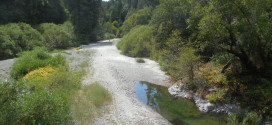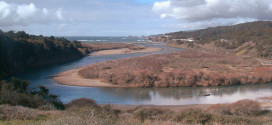Two separate reports by Residents of The Sea Ranch
Report No. 1
Several of us walked to the bluff next to Gualala Point Island rookery to monitor the fireworks’ effect on rookery residents, not knowing WHAT to expect – IF anything. We were amazed and troubled by how immediate and extensive the effect was.
Alarm cries from the seabirds began right after the first few small flashes and booms and increased in number, volume and pitch with subsequent displays. A large cloud of birds flew off the rookery, increasing in numbers and height with each explosion. The cloud of birds was joined from the south end of the island by larger birds, which despite the dark, from their size, looked like pelicans. As the louder, higher, brighter bursts came in more rapid succession the entire east slope of the island, hundreds of feet long and perhaps 100 feet high, was repeatedly illuminated by flashes of light from the exploding fireworks less than a mile distant.
The louder bursts REVERBERATED and echoed back off the east slope of the Island to us on shore. In between rocket bursts and echoes, one could hear the increasing cacophony of what sounded like hundreds of birds. When the barrage finally stopped and we walked back to the car, we could tell by the sounds and directions of the continuing bird cries, that some disoriented birds were STILL FLYING ABOUT between the island and the shore to the south.
These exhausted birds, with their sleep disrupted, are not as effective hunters next day for themselves and their young as would otherwise be the case. Their very survival depends on finding enough food daily, despite the second poor fishing year in a row for seabirds. There are wildlife consequences beyond the transient human thrill. One just needs to have an open mind and find the right places to observe.
Report No. 2
At about 9:15 on the night of July 2, two loud booms (no fireworks as yet) sounded as I walked with two friends toward the bluff trail, headed for an excellent view of Gualala Point Island and its bird rookery. A few minutes later, the fireworks began with a few low sputtering bursts, then came louder explosions with brighter flashes of light. Between the Island and the rocky shore point to the south, across the bluff trail from Rich Kuehn’s house, we could hear the agitated cries of many birds, but visibility to the south was not as good as that provided by a cloudbank at the horizon line. A bright quarter moon hung above this cloud bank. We stood with backs to the fireworks to best observe effects on the island’s rookery and nearby coastal area, not knowing what to expect–if anything.
We were amazed and troubled by how immediate and extensive the response was. The louder, brighter rockets continued, and the cloud of birds increased in numbers and rose higher; it was joined from the south end of the island by larger birds, which from their size and dark outline against the grey cloud behind, I took to be pelicans. We saw a third type of bird, possibly a guillemot, but it whizzed low by the SE shore of the island, and the visibility there was poor. The louder, higher, brighter bursts came in more rapid succession and the entire east slope of the island, hundreds of feet long and perhaps comprising a 100 feet of sloping land from water to ridgeline, was repeatedly illuminated by flashes of light from the exploding fireworks less than a mile distant.
In the air above the island, one could see an agitated cloud of many birds, which from the bluff trail looked like a cloud of flies buzzing above a carcass. The louder bursts reverberated and echoed off the east slope of the Island. In between rocket bursts and echoes, one could hear the increasingly agitated cacophony of hundreds of birds.
When the barrage finally stopped, we walked very slowly back to where we were parked near Rich’s house, pausing to listen. It was too dark to see much by then, but from the sounds and directions of the continuing bird cries, some birds were still flying about between the island and the coastal point to the south. When we reached the car, cries from the island and the shore area could still be heard.
Surely these stressed birds with their sleep disrupted will not be as effective hunter for themselves and their young today, though their survival depends on finding and catching food. As those with me can attest, I kept my eyes on the island and not on the fireworks, except to glance in the direction of Gualala from time to time to see how high they were reaching in the sky over the estuary before exploding.
Saturday night, I attended the fireworks at Point Arena. There I saw at least 3 rockets actually enter the water of the cove, one of which exploded in glowing fragments after entering the surface of the water. I wonder if any of the fireworks shot from Gualala, whether “duds” or actual explosions, entered the water of the Gualala Estuary? I couldn’t see the river from where I was watching the CCNM’s Gualala Point Island.
 Friends of Gualala River Protecting the Gualala River watershed and the species living within it
Friends of Gualala River Protecting the Gualala River watershed and the species living within it


